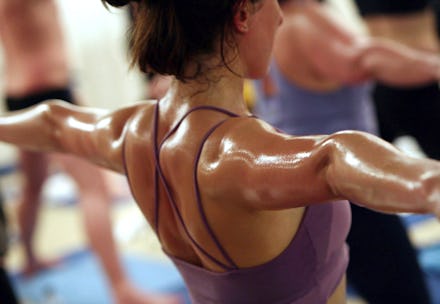Is Bikram Yoga Dangerous? Here Are the Possible Health Risks — And Why It's Not Hot Yoga

When you think of hot yoga, you typically think of an enclosed room, humidity and sweating. Though its purported detoxifying benefits have been more or less debunked, there is a sort of "psychological benefit" of practicing yoga in a heated room in that you feel "rinsed out," not unlike a sauna.
Bikram yoga, on the other hand, is sort of like hot yoga's sadistic cousin.
Read more: Marijuana and Yoga: Should You Get High Before Yoga Class?
Named eponymously after its creator, Bikram Choudhury, Bikram yoga seems similar to hot yoga on the surface, but after the humid steam dissipates, it becomes clear that it is not.
According to Boston magazine's Megan Tripp, hot yoga and Bikram are delineated by temperature, poses and (surprisingly) decor. While a combination of different poses may be practiced in hot yoga, Bikram yoga comprises of the same 26 poses, done in the same order along with two breathing exercises. Bikram yoga also has a list of atmospheric specifications like absolute silence (i.e., no music or talking), to studio specifications like bright lights and mirrors installed on the front fall, as well as carpeted floors. Finally, hot yoga rooms are heated between 80 and 100 degrees, whereas in Bikram yoga, the room must be heated to 105 degrees, with a kicker of 40% humidity.
In April 2015, a group of researchers from the University of Wisconsin who were enlisted by the American Council on Exercise to research Bikram yoga shared a study on how the heat from a typical 90-minute Bikram yoga session affected the core temperature of participants. "For many Bikram enthusiasts, having the mental strength and focus to overcome this type of challenge is a big part of the draw," the researchers reported. "It is primarily advocates of this extreme version of 'hot yoga' who claim improved mindfulness, flexibility, strength, muscle tone and general fitness as a direct result of practicing this form of yoga."
One of the main criticisms of hot yoga is the threat of dehydration, which is all the more prevalent in Bikram yoga due to the scorching temperatures and stringent class time of 90 minutes. Very commonly, classes only designate one official break for water. There is also the threat of elevated core temperature; the researchers stated that "While none of these subjects exhibited signs or symptoms of heat intolerance, core temperatures such as these can pose concern for some participants, as the risk for heat-related illness increases at 104 degrees."
Perspiration is the body's natural way of cooling off, but during a sweltering and humid heatwave not, unlike a Bikram yoga studio, the Centers for Disease Control and Prevention noted that sweat isn't able to evaporate as quickly, which only contributes to a rise in body temperature. Prolonged exposure to these oppressive conditions can result in heat exhaustion and even heatstroke.
With all that said, the researchers reported that there might be a way to help lessen the threats associated with Bikram yoga, including shortening the class to 60 minutes, lowering the temperature and allowing more opportunities for hydration.